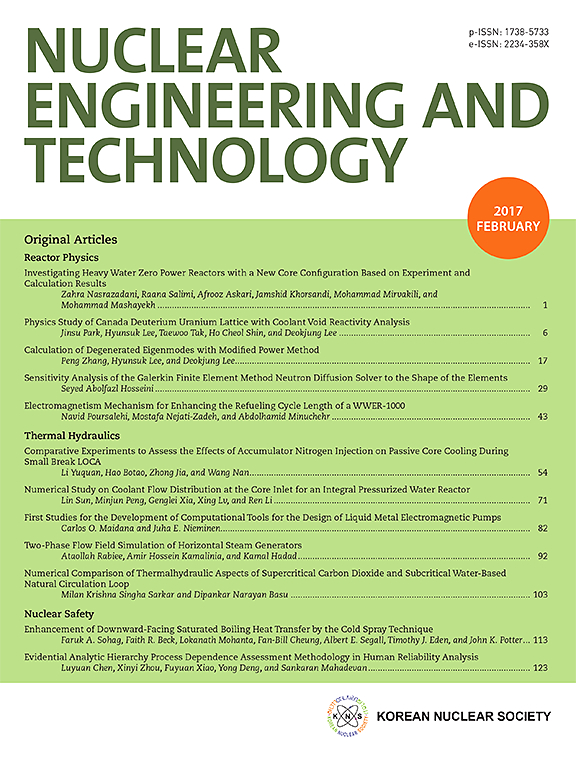Robust dosimetric evaluation of FLASH proton beams using plane-parallel ionization chambers and EBT-XD films for pre-clinical studies
IF 2.6
3区 工程技术
Q1 NUCLEAR SCIENCE & TECHNOLOGY
引用次数: 0
Abstract
This study established a robust methodology to evaluate the beam quality and dosimetric characteristics of FLASH-Proton beams. Dose plans were formulated for delivery of 3, 6, and 9 Gy at rates of 40 Gy/s and 70 Gy/s. The dosimetric evaluation employed two plane-parallel ionization chambers (ICs)—PPC-05 and Advanced Markus chamber—alongside EBT-XD film. Key parameters such as recombination and polarity effects of the ICs were measured, and the determined dose was quantified at predefined depths. Beam characteristics were further investigated using the EBT-XD film to corroborate IC findings. Polarity correction factors calculated for PPC-05 were 0.997 and 0.996 at 40 Gy/s and 70 Gy/s, respectively, with corresponding values for the Advanced Markus chamber of 1.0 and 0.999. The mean dose rates, derived from log files, were 52.3 Gy/s and 72.8 Gy/s for nominal rates of 40 Gy/s and 70 Gy/s, respectively. Depth dose profiles from the EBT-XD were analyzed at seven points and compared with measurements from PPC-05, revealing relative dose differences within ±5 % upon application of linear energy transfer correction. The established methodology is validated for routine clinical quality assurance.
使用平面平行电离室和EBT-XD薄膜进行临床前研究的FLASH质子束的稳健剂量学评估
本研究建立了一种可靠的方法来评估flash -质子束的光束质量和剂量学特性。制定了剂量计划,分别以40 Gy/s和70 Gy/s的速率给药3、6和9 Gy。剂量学评价采用两个平面平行电离室(ic) -PPC-05和Advanced Markus室-与EBT-XD膜。测量了ic的复合效应和极性效应等关键参数,并对预定深度下的剂量进行了量化。利用EBT-XD薄膜进一步研究了光束特性,以证实IC的发现。在40 Gy/s和70 Gy/s条件下,PPC-05的极性校正系数分别为0.997和0.996,而Advanced Markus实验室的极性校正系数分别为1.0和0.999。从日志文件得出的平均剂量率分别为52.3戈瑞/秒和72.8戈瑞/秒,标称剂量为40戈瑞/秒和70戈瑞/秒。分析了EBT-XD在7个点的深度剂量分布,并与PPC-05的测量结果进行了比较,在应用线性能量传递校正后,显示了±5%的相对剂量差异。所建立的方法被验证为常规临床质量保证。
本文章由计算机程序翻译,如有差异,请以英文原文为准。
求助全文
约1分钟内获得全文
求助全文
来源期刊

Nuclear Engineering and Technology
工程技术-核科学技术
CiteScore
4.80
自引率
7.40%
发文量
431
审稿时长
3.5 months
期刊介绍:
Nuclear Engineering and Technology (NET), an international journal of the Korean Nuclear Society (KNS), publishes peer-reviewed papers on original research, ideas and developments in all areas of the field of nuclear science and technology. NET bimonthly publishes original articles, reviews, and technical notes. The journal is listed in the Science Citation Index Expanded (SCIE) of Thomson Reuters.
NET covers all fields for peaceful utilization of nuclear energy and radiation as follows:
1) Reactor Physics
2) Thermal Hydraulics
3) Nuclear Safety
4) Nuclear I&C
5) Nuclear Physics, Fusion, and Laser Technology
6) Nuclear Fuel Cycle and Radioactive Waste Management
7) Nuclear Fuel and Reactor Materials
8) Radiation Application
9) Radiation Protection
10) Nuclear Structural Analysis and Plant Management & Maintenance
11) Nuclear Policy, Economics, and Human Resource Development
 求助内容:
求助内容: 应助结果提醒方式:
应助结果提醒方式:


